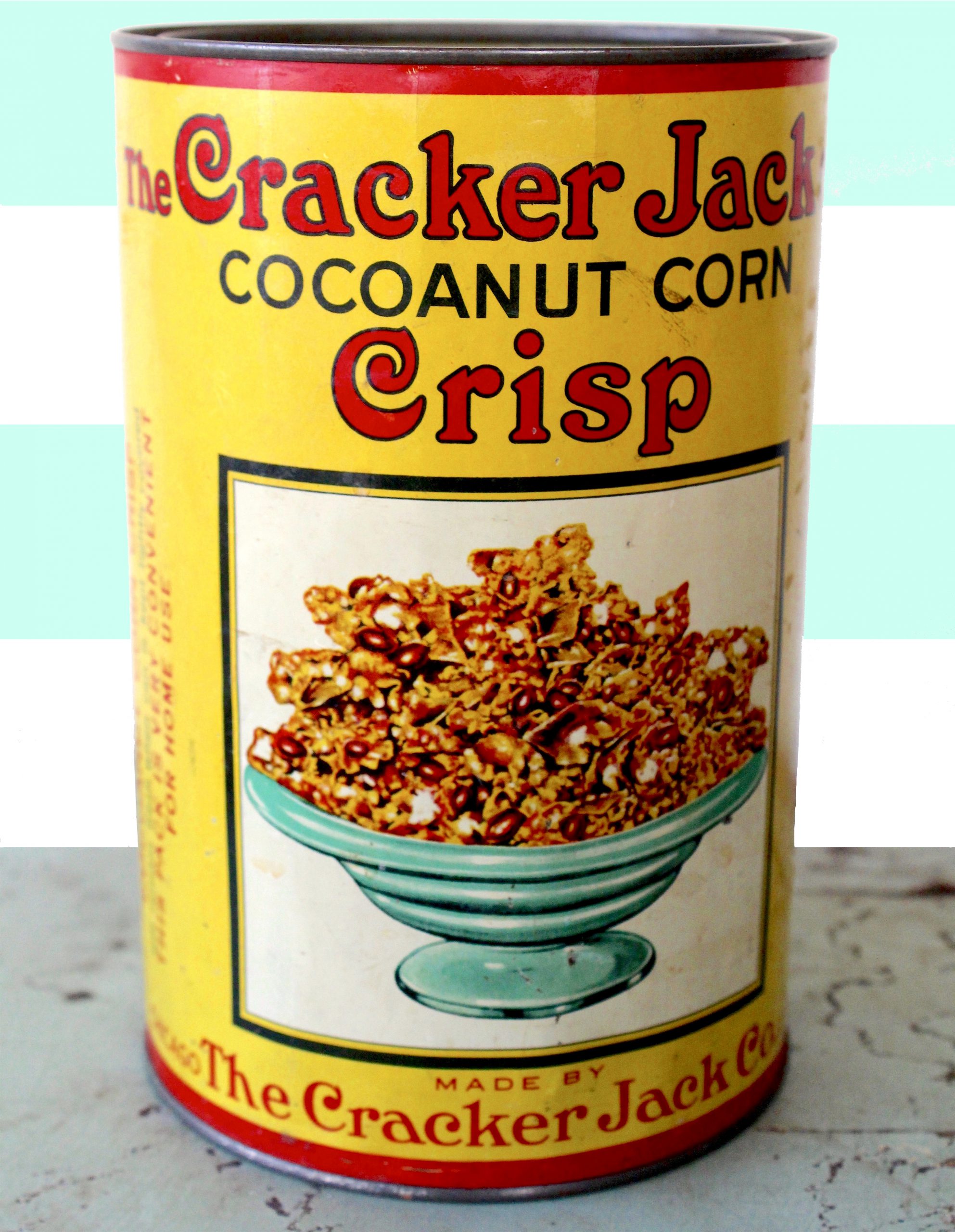
Museum Artifact: Cracker Jack Cocoanut Corn Crisp Tin, c. 1930
Made By: The Cracker Jack Company, 4800 W. 66th Street, Chicago, IL [Clearing]
“You can eat as much as you like!” That’s how the Cracker Jack Company marketed its new Cocoanut Corn Crisp to America in 1928, assuring all snackers that these “luscious lumps of goodness” were “healthful, pure, and wholesome.” Not being a doctor or nutritionist, I can’t speak to these claims 90 years after the fact, but I am going to guess they were slightly inaccurate.
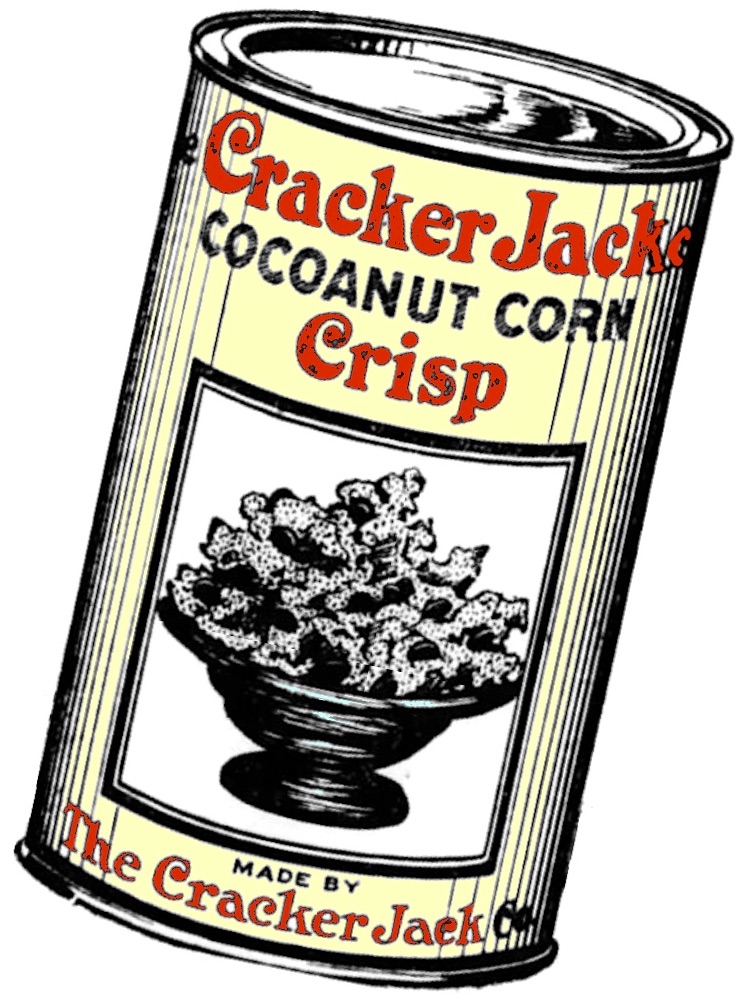 Cocoanut Corn Crisp was really just a subtle variation on the well established Cracker Jack formula (America’s proto junk food), adding coconut flakes to the Chicago company’s trademark mixture of peanuts, popcorn, and molasses. Unlike the original, however, this new concoction was sold in a big yellow tin rather than a red, white and blue carton. The famous Cracker Jack mascots—Sailor Jack and his little dog Bingo—were also absent from the packaging, as you can see from the artifact in our museum collection. All in all, these aesthetic change-ups might have gone a step too far. Cocoanut Corn Crisp never quite caught on with the public, and it would disappear for good by the next decade—another victim of the Great Depression.
Cocoanut Corn Crisp was really just a subtle variation on the well established Cracker Jack formula (America’s proto junk food), adding coconut flakes to the Chicago company’s trademark mixture of peanuts, popcorn, and molasses. Unlike the original, however, this new concoction was sold in a big yellow tin rather than a red, white and blue carton. The famous Cracker Jack mascots—Sailor Jack and his little dog Bingo—were also absent from the packaging, as you can see from the artifact in our museum collection. All in all, these aesthetic change-ups might have gone a step too far. Cocoanut Corn Crisp never quite caught on with the public, and it would disappear for good by the next decade—another victim of the Great Depression.
It was quite a different story for good old Cracker Jack 1.0, of course. The original recipe, introduced in 1896, is still around today (albeit with a notably decreased peanut count), and it has come to occupy a very unique place in America’s confectionery landscape. Not since figgy pudding has there been a treat like this one—consistently sung about more often than it’s actually eaten. Even among its true devotees, a decision to buy a box of Cracker Jacks has generally been more about unearthing the “prize inside” than enjoying the snack itself. Hence the backlash in 2016 when current parent-company Frito-Lay announced it would permanently discontinue all physical Cracker Jack toys and replace them with digital download codes. Sacrilege! Sure, everybody knew the prizes had been on a steep decline in quality for decades, but still, it was the principle of the thing!
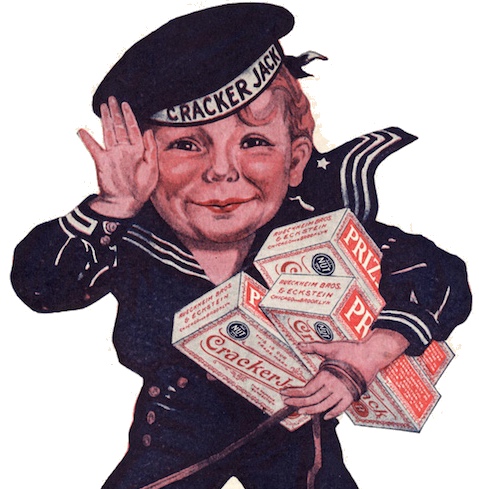 Evolution of any kind is tough with a brand like this. Cracker Jack’s enduring place in the culture is clearly rooted in an appealingly folksy brand of nostalgic Americana. The sailor boy, “Take Me Out of the Ballgame,” the silly promotional gimmicks—it all feels sort of naively authentic and non-threatening; a reminder of a time when gluttonous excess was still cute.
Evolution of any kind is tough with a brand like this. Cracker Jack’s enduring place in the culture is clearly rooted in an appealingly folksy brand of nostalgic Americana. The sailor boy, “Take Me Out of the Ballgame,” the silly promotional gimmicks—it all feels sort of naively authentic and non-threatening; a reminder of a time when gluttonous excess was still cute.
The reality, though, is that Cracker Jack was, from its earliest days, a product born on the battlefield of cutthroat capitalism. And for the German immigrants who created it—a pair of brothers accused of everything from child labor abuses to outright treason—a legacy of cuddly American patriotism was truly earned the hard way.
Ashes to Molasses
Frederick William Rueckheim was born in Japenzin, Germany, in 1846, but his loyalties, more specifically, rested with Prussia, as he fought for that side in the Prussian-Austrian War of 1866. Three years later, he immigrated to the U.S., joining many of the veterans from another recent war, all seeking a better life in the great American West.
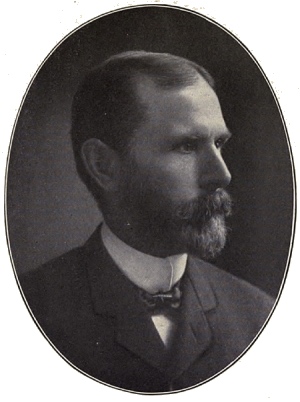 Rueckheim’s adventures in the New World got off to an inauspicious start—he was instructed to meet up with his uncle in the Chicago-adjacent town of Washington Heights, where he’d have work awaiting him on a farm. At age 23, well educated and battle tested, this wasn’t what Frederick had in mind. Trips into the city became frequent, and when the Great Chicago Fire flattened the skyline in 1871, Rueckheim decided to head north and help with the cleanup effort.
Rueckheim’s adventures in the New World got off to an inauspicious start—he was instructed to meet up with his uncle in the Chicago-adjacent town of Washington Heights, where he’d have work awaiting him on a farm. At age 23, well educated and battle tested, this wasn’t what Frederick had in mind. Trips into the city became frequent, and when the Great Chicago Fire flattened the skyline in 1871, Rueckheim decided to head north and help with the cleanup effort.
From here, we enter into Cracker Jack company lore, as Fred Rueckheim—carrying the $200 he’d managed to pack away from his uncle’s meager stipend—met a fella named William Brinkmeyer out on the city salvage circuit. Before the fire, Brinkmeyer had been the fairly successful owner of a Chicago popcorn stand. Now, in an effort to feed the determined folks rebuilding the city, Rueckheim put up his stash of cash to re-establish Brinkmeyer’s business. They operated out of a backroom, utilizing one molasses kettle and a single popper. Spoiler alert: it was a big success.
An energized Rueckheim decided that he’d found his calling. The actual making of the popcorn wasn’t all that interesting, but the salesmanship and promotion of the product came naturally to him—and selling corn out of a downtown wagon sure beat chucking it in Washington Heights.
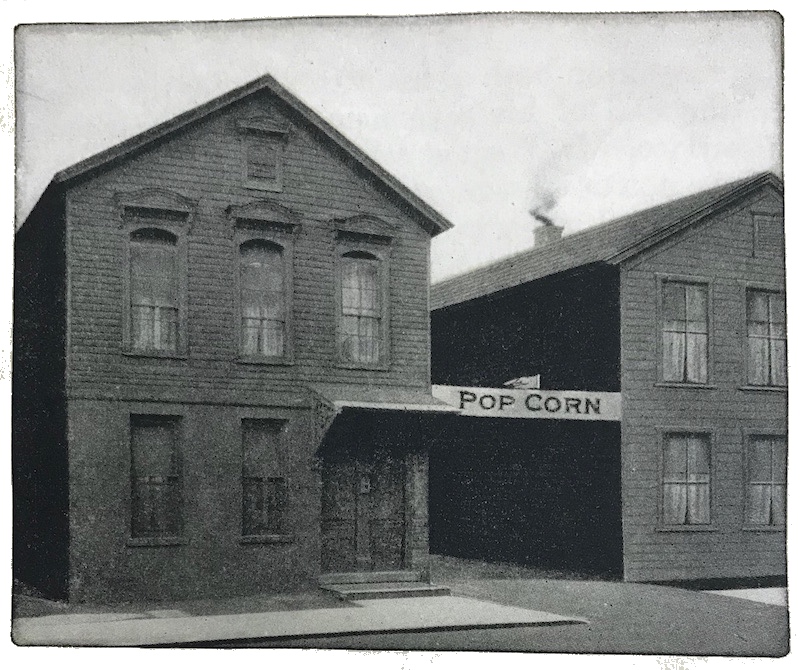 [The humble Rueckheim popcorn HQ on E. Van Buren Street, 1872]
[The humble Rueckheim popcorn HQ on E. Van Buren Street, 1872]
By 1873, Brinkmeyer was politely elbowed out of the business, and Frederick summoned his younger brother Louis Rueckheim—a recent veteran of still another war (Franco-Prussian)—to follow his path and join him in Chicago. Their new business, established as F. W. Rueckheim & Bro., was essentially born right alongside the rise of the new Chicago.
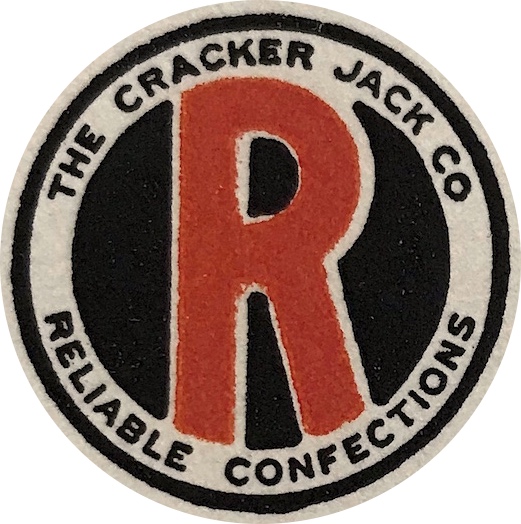 Selling popcorn bricks out of a tiny office on East Van Buren Street, the brothers were determined to use their German ingenuity to out-hustle the competition. When Frederick caught wind that a local Dutch confectioner was headed back to Holland, for example, he boldly bought the guy’s entire collection of candy-making equipment and challenged Louis to make something out of the mess. Louis, conveniently enough, found his own calling in the candy sciences, and Rueckheim & Bro’s official brand of “Reliable Confections” was developed, complete with a trademark “R” logo that would remain in use for more than 50 years. Cracker Jack, as of yet, wasn’t even on the radar.
Selling popcorn bricks out of a tiny office on East Van Buren Street, the brothers were determined to use their German ingenuity to out-hustle the competition. When Frederick caught wind that a local Dutch confectioner was headed back to Holland, for example, he boldly bought the guy’s entire collection of candy-making equipment and challenged Louis to make something out of the mess. Louis, conveniently enough, found his own calling in the candy sciences, and Rueckheim & Bro’s official brand of “Reliable Confections” was developed, complete with a trademark “R” logo that would remain in use for more than 50 years. Cracker Jack, as of yet, wasn’t even on the radar.
In 1885, F. W. Rueckheim & Bro. moved into a building on South Clinton Street—a three-story brick testament to the business’s legitimacy. Two years in, it burned to the ground—all equipment, all raw materials, gone. The Rueckheims, both still in their 30s, could have assessed the damage, counted their losses, and called it a day. Instead, they rebuilt and upgraded—installing more advanced machines for automation and greater efficiency.
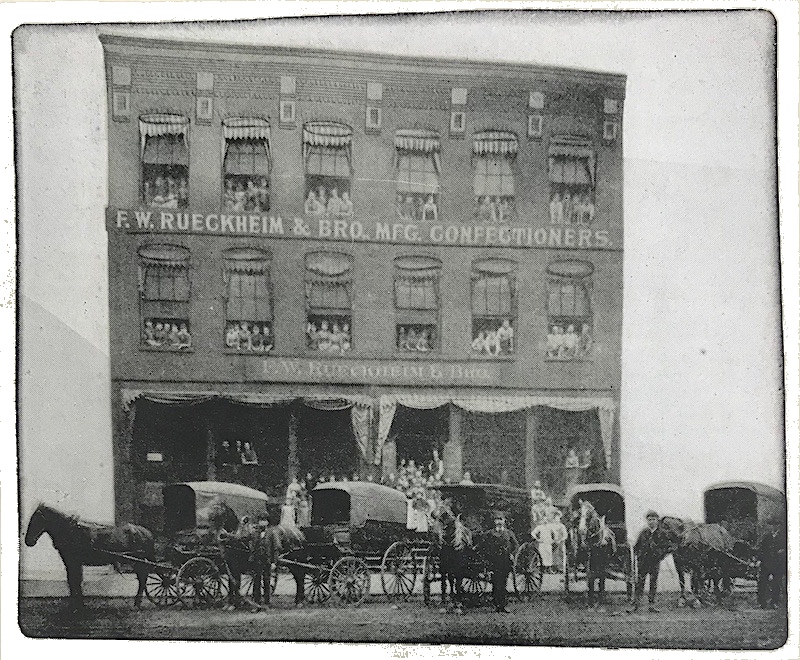 [Rueckheim building on South Clinton Street, 1885, along with the company staff and sales wagons]
[Rueckheim building on South Clinton Street, 1885, along with the company staff and sales wagons]
“This steady growth,” according to the company’s 1922 golden anniversary book, Fifty Years, “was a tribute to the industry and frugality of the two brothers. The business never had been adequately financed. It was only by stern self-denial for many years that there was sufficient capital available to meet obligations with promptness.”
“Self denial” might have kept them in business, but after 20 years in the industry, the Rueckheims were still looking for something to elevate them above the fray and solidify their financial standing once and for all. And the 1893 Columbian Exposition sure seemed like a great opportunity to do it.
Let’s Get Poppin’
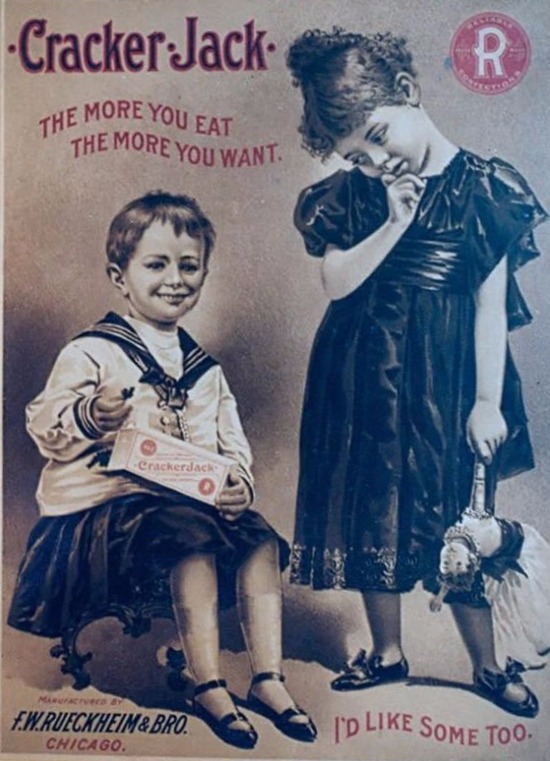 Countless tellings of the Cracker Jack story begin at Chicago’s first World’s Fair, with the Rueckheims introducing a new caramelized popcorn that instantly becomes one of the exhibition’s great sensations. There’s just one small problem with this oft-repeated yarn—there’s no evidence to suggest it ever happened.
Countless tellings of the Cracker Jack story begin at Chicago’s first World’s Fair, with the Rueckheims introducing a new caramelized popcorn that instantly becomes one of the exhibition’s great sensations. There’s just one small problem with this oft-repeated yarn—there’s no evidence to suggest it ever happened.
F. W. Rueckheim & Bro. was certainly in business in 1893, and it makes sense to presume they had some sort of presence at the Exhibition. We just don’t know anything about that presence, let alone any details on whether a prototype of Cracker Jack was being sold there. All stories that say otherwise seem to originate from later myths perpetuated by Cracker Jack’s second parent company, Borden, Inc. By contrast, the Rueckheims’ own 50-year company history makes no mention of the World’s Fair at all, and the MANY books from the fair itself are similarly lacking in such tales.
One of the first press reports of Cracker Jack that we do have on record—from the March 8, 1896 issue of the Chicago Tribune—describes the confection as a very recent invention; scrounged up by Louis Rueckheim as a happy accident. Since this article feels more like a thinly veiled advertisement than anything resembling real journalism, the truth is probably still somewhere between the cracks, but it’s a fun read nonetheless, and showcases Cracker Jack’s emergence as the Rueckheim’s long awaited smash hit.
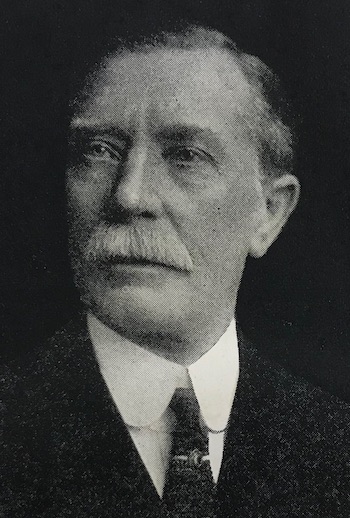 “Do Not Taste It,” read the ridiculous headline. “If you do, you will part with your money easy.”
“Do Not Taste It,” read the ridiculous headline. “If you do, you will part with your money easy.”
“As luck would have it, Louis Rueckheim [pictured], a Chicago candy manufacturer, recently hit upon a very bright, new idea in confections. Nearly everybody has a ‘sweet tooth,’ which keeps the manufacturers busy, working up new schemes for captivating the popular taste. Mr. Rueckheim had been dabbling around in his laboratory of sweetness when the aforesaid bright idea entered creation. Then followed an eager consultation with the foreman of his ‘composing room,’ and immediately they fixed up the first batch of the new candy. Then they tasted the hot stuff, rolled their eyeballs in pleased astonishment, and exclaimed: ‘Das ist ausgezeichnet!’ That’s how Cracker Jack was discovered.”
Later versions of this same story often cast the unnamed co-worker as an English speaker, and have him exclaiming “That’s cracker-jack!” during the first taste test, thus inspiring the actual naming of the product. There’s pretty much zero chance it went down like that, either. Instead, the easy explanation is that “crackerjack” was already a common expression of the day—a synonym for “excellent”—and Frederick Rueckheim simply realized he could seize on the slang and copyright it, which he did. Perpetuating a more interesting origin story in the aftermath created a marketable mythology that’s largely carried on for over 100 years. These guys were smart.
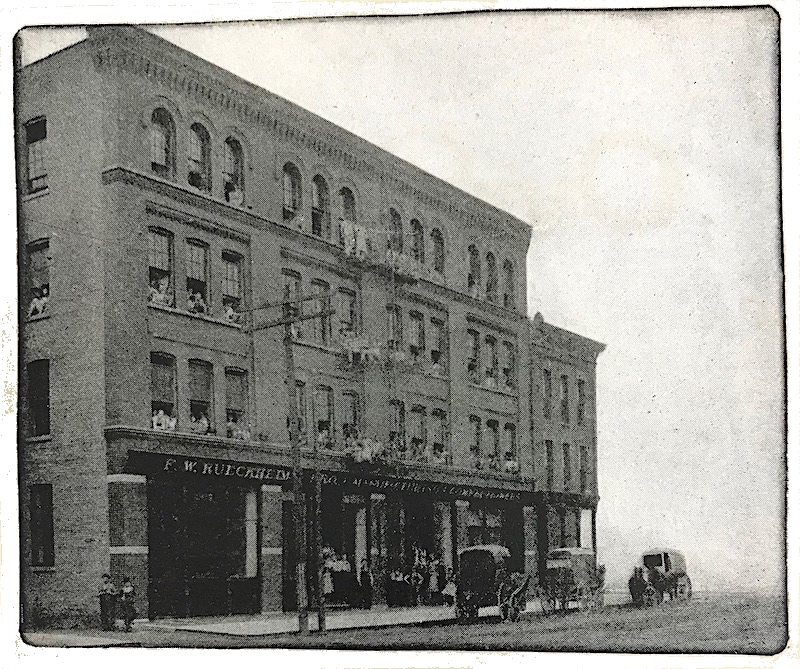 [Rueckheim & Bro’s factory at 261 Desplaines St., 1895]
[Rueckheim & Bro’s factory at 261 Desplaines St., 1895]
“The manager of a great department store, ever on the lookout for something that’s new and taking, quickly preempted the first output of Cracker Jack,” continued the 1896 Tribune article. “Did it sell? Well, I should guess yes! Why, the way that Cracker Jack disappeared was a regular eye-opener to all interested. Even the firm hadn’t expected the new candy to become a sudden fad.
“But it did. At the same time, the jobbers, or middle men, each took Cracker Jack along to show to the retail confectioners, the grocers, and the druggists. After that, these men about town brought in daily orders for larger lots. The hunger for Cracker Jack developed so rapidly that the factory has since been working overtime to supply the demand. A jobber aptly remarked: ‘Cracker Jack reminds me of fishing. Offering Cracker Jack for sale is like baiting a hook. When the fish bite they’re caught. When people bite Cracker Jack they, too, are caught.’”
That anonymous jobber might as well have been Frederick Rueckheim himself, and in all likelihood, he probably wrote the article.
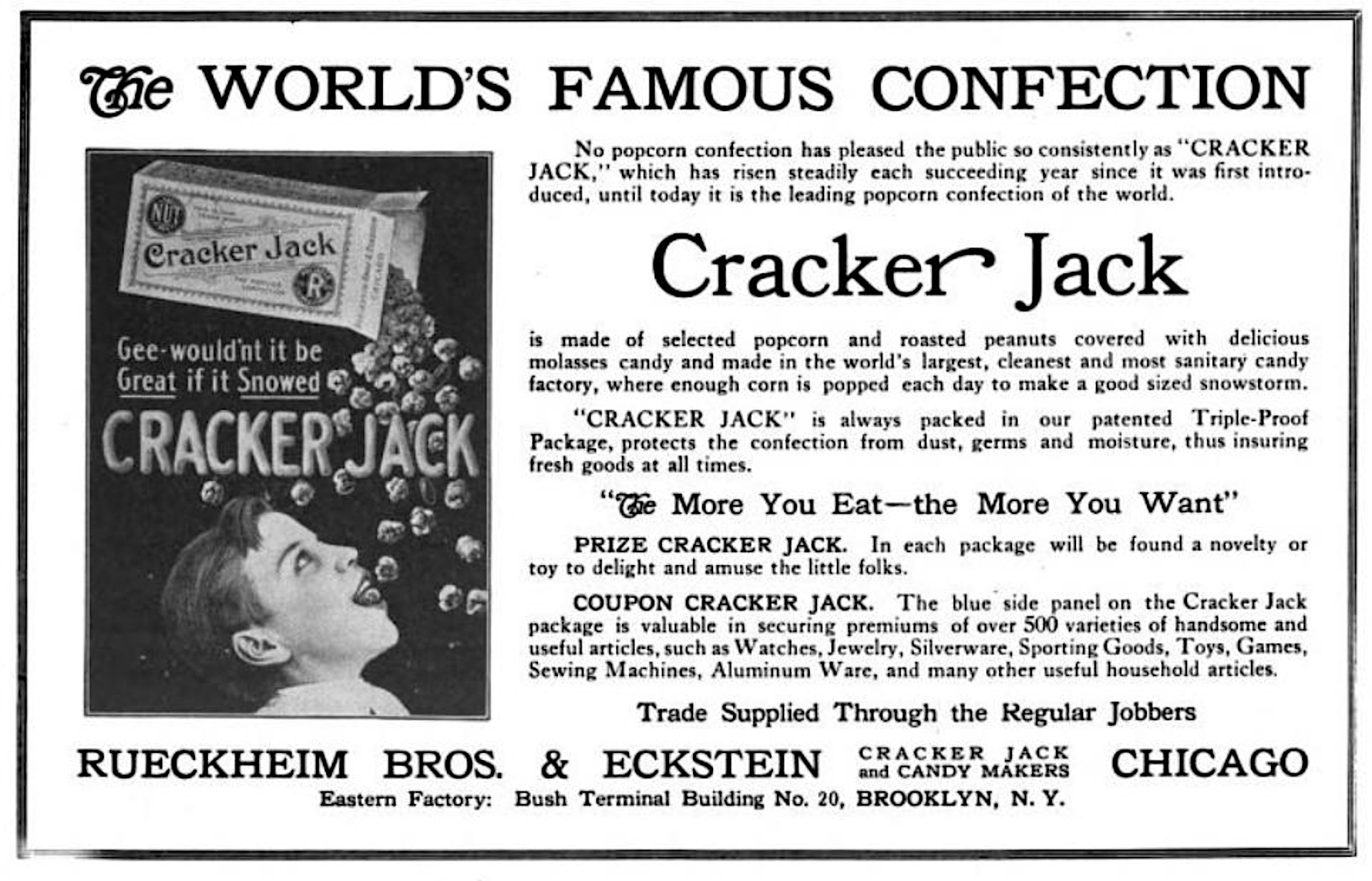 [Cracker Jack magazine ad, 1915]
[Cracker Jack magazine ad, 1915]
“I Don’t Care If I Never Get Back”
There were a couple key technical innovations that really separated Cracker Jack from the legions of similar candies out on the market at the turn of the century.
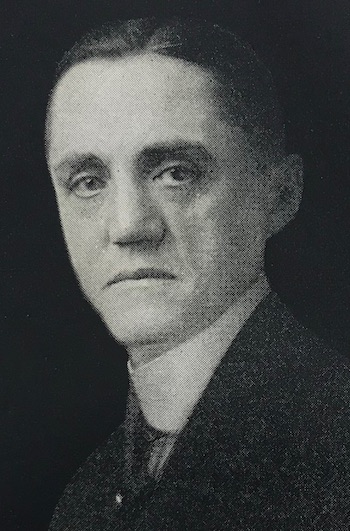 First, Louis Rueckheim figured out how to prevent the individual morsels from sticking together into a coagulated gooey mess—some sort of barrel rotation trick. This made the stuff exceedingly more edible. Second, a new addition to the company, Henry G. Eckstein, came up with a way to better preserve the freshness and crispness of the snack for those long shipments back to the east coast. In 1899, his “waxed sealed package” enabled F. W. Rueckheim & Bro. to sell their product in slim waterproof cartons instead of expensive, bulky tins. The company rewarded him a few years later by officially re-organizing as Rueckheim Bros. & Eckstein—now headquartered out of a 400-employee stronghold at 261 Desplaines Street.
First, Louis Rueckheim figured out how to prevent the individual morsels from sticking together into a coagulated gooey mess—some sort of barrel rotation trick. This made the stuff exceedingly more edible. Second, a new addition to the company, Henry G. Eckstein, came up with a way to better preserve the freshness and crispness of the snack for those long shipments back to the east coast. In 1899, his “waxed sealed package” enabled F. W. Rueckheim & Bro. to sell their product in slim waterproof cartons instead of expensive, bulky tins. The company rewarded him a few years later by officially re-organizing as Rueckheim Bros. & Eckstein—now headquartered out of a 400-employee stronghold at 261 Desplaines Street.
If the Rueckheims were willing to add Henry Eckstein’s name to the door for designing a bag, they probably should have done at least as much for Jack Norworth. He’s the Tin Pan Alley singer who, in 1908, penned a little ditty called “Take Me Out to the Ballgame” (incidentally, he’d never been to one). To maintain a proper rhyme scheme, Norworth lazily name-checked his favorite confection in the lyrics—“Buy me some peanuts and Cracker Jack . . .”
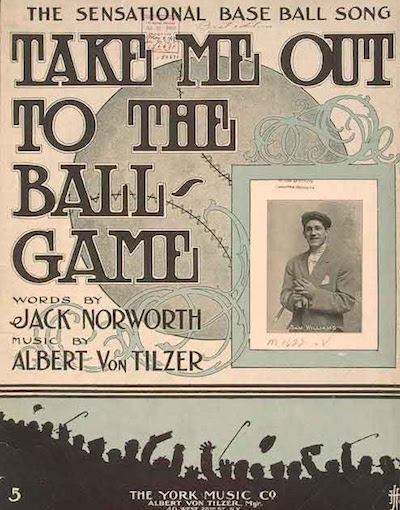 When the song subsequently became the year’s biggest hit, nobody was more blindsided than the guys at the Rueckheim offices. Without lifting a finger, they’d become the beneficiaries of perhaps the greatest pro bono marketing campaign in American history. And boy did it have legs.
When the song subsequently became the year’s biggest hit, nobody was more blindsided than the guys at the Rueckheim offices. Without lifting a finger, they’d become the beneficiaries of perhaps the greatest pro bono marketing campaign in American history. And boy did it have legs.
From the Vaudeville circuit to sheet music, piano rolls, and eventually early phonograph records and radio, the song continued to nestle its way into the public consciousness year after year. It was the country’s first great sports anthem, and by a stupid stroke of luck, it permanently correlated the Cracker Jack name with America’s pastime—a free ad in every rendition, ad nauseum.
Though little is known about Fred and Louis Rueckheim’s actual reaction to this “Take Me Out” phenomenon, it seemed to at least open their eyes to some more promotional possibilities outside the usual norms. Theoretically, it also turned them into born again baseball fans.
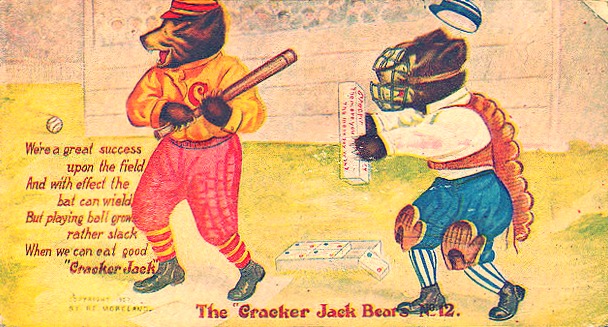 [Before the Sailor Boy mascot was created, the little known “Cracker Jack Bears” were featured on promotional postcards in the early 1900s]
[Before the Sailor Boy mascot was created, the little known “Cracker Jack Bears” were featured on promotional postcards in the early 1900s]
“A Prize In Every Box”
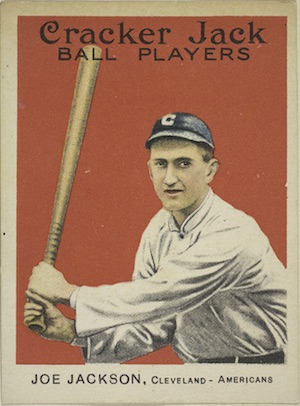 Shortly after “Take Me Out to the Ballgame” was released, the first prizes started appearing in Cracker Jack boxes, many of them baseball related in theme. Selling tie-ins or premiums with a main product wasn’t a new concept, but the sheer volume of the Rueckheim’s operation was unprecedented.
Shortly after “Take Me Out to the Ballgame” was released, the first prizes started appearing in Cracker Jack boxes, many of them baseball related in theme. Selling tie-ins or premiums with a main product wasn’t a new concept, but the sheer volume of the Rueckheim’s operation was unprecedented.
The first run of prizes in 1910 were initially just coupon cards geared more toward a grown-up audience, but by 1912, the company was tucking tin soldiers, paper dolls, spinner toys, and other assorted kids stuff right in there with the peanuts and popcorn.
A few years after that, the first iconic Cracker Jack baseball cards made their debut, featuring stars of the day like Honus Wagner, Ty Cobb and “Shoeless” Joe Jackson. These cards, as with most of the other premiums, were produced in collectable sets, thus giving kids an added motivation—or perhaps their only motivation—to keep eating Cracker Jacks.
A “prize in every box” didn’t always live up to one’s expectations, of course, even in the golden era of Cracker Jack toys.
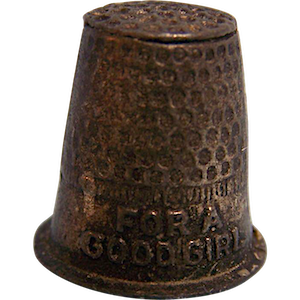 In the ‘20s and ‘30s, a kid might get to the bottom of a box only to find a tiny diecast “thing”—a hat, a boot, maybe a thimble or an iron (you can easily visualize little Timmy’s perplexed face). Of course, when those same diecast molds wound up as Monopoly game pieces a wee bit later, it was no coincidence. They were all manufactured by another pair of Chicago siblings—the Dowst Brothers—who had shifted from the family laundry business into making the popular TootsieToy line of trinkets.
In the ‘20s and ‘30s, a kid might get to the bottom of a box only to find a tiny diecast “thing”—a hat, a boot, maybe a thimble or an iron (you can easily visualize little Timmy’s perplexed face). Of course, when those same diecast molds wound up as Monopoly game pieces a wee bit later, it was no coincidence. They were all manufactured by another pair of Chicago siblings—the Dowst Brothers—who had shifted from the family laundry business into making the popular TootsieToy line of trinkets.
As a very cheap snack food offering very cheap prizes—the actual Cracker Jack product stood in pretty stark contrast to the growing wealth and public standing of the Rueckheim family itself. For these determined Germans, several decades of calculated product development had helped them realize the full potential of the proverbial “American dream,” and they embraced all the perks that came with it.
Frederick Rueckheim and his second wife Ola became figures of Chicago high society, and daughter Laura—an opera singer trained by the best instructors in Berlin—made international headlines when she married her personal portrait artist, Frank Werner, who’d already won acclaim for his painstakingly romantic depiction of her. Werner later left his brushes behind and became a vice president and treasurer of the Cracker Jack Co.
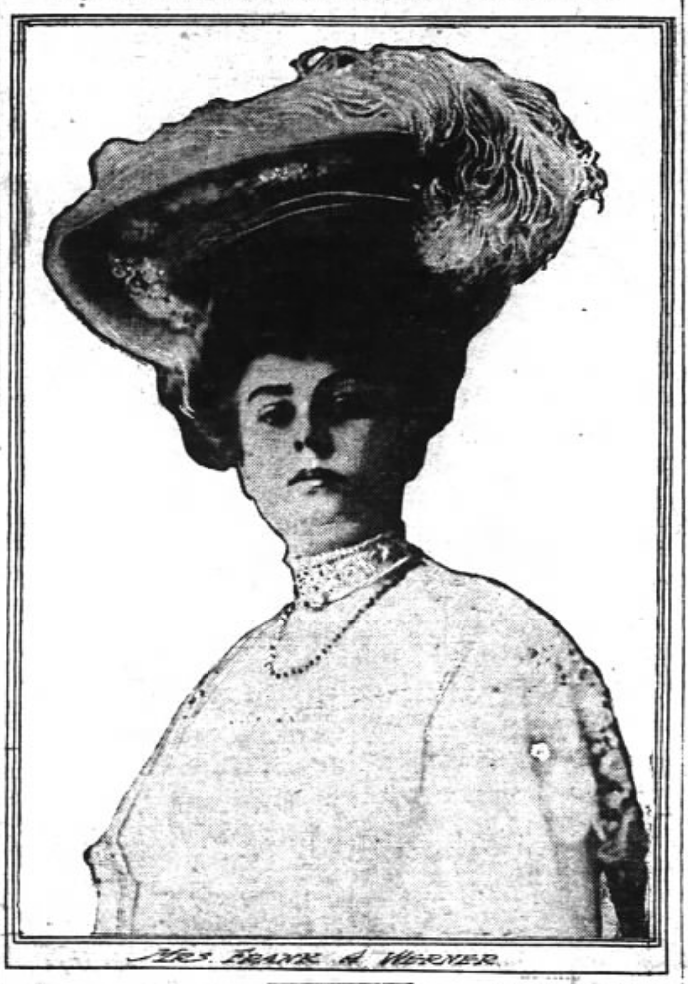 [Worldly sophisticate Laura Rueckheim married her own portrait artist, the well-to-do painter Frank Werner of Akron, OH]
[Worldly sophisticate Laura Rueckheim married her own portrait artist, the well-to-do painter Frank Werner of Akron, OH]
Beneath all this sheen and sophistication, though, lurked a darker side—a brutal truth all too common in this era of Chicago industry. Sometimes, the Cracker Jack slogan—“The More You Eat, the More You Want”—became an applicable metaphor for how the Rueckheims ran their business. Uncompromising and self-serving.
Devils in the Details
Feeling under constant threat from confectionery rivals and copycats, the company used every means necessary to cut production costs while increasing output. This included hiring as many as 200 child laborers in the early 1900s—an offense that wasn’t always blatantly illegal at the time, but which got the Rueckheims cited on numerous occasion for hiring workers below the allowable age of 14—most of them girls.
This practice generated some particularly ugly press in 1902, when two women from an advocacy group were barred from entering the Rueckheim plant to assess the legality of its workforce.
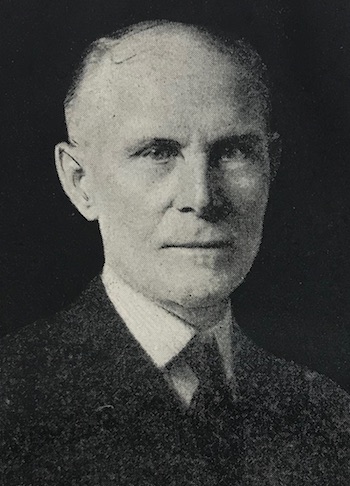 According to the December 23 issue of the Tribune, Frederick Rueckheim rebuffed the women with the following tirade:
According to the December 23 issue of the Tribune, Frederick Rueckheim rebuffed the women with the following tirade:
“You can’t come in! I propose to run this factory according to my ideas, not yours. You women seem to think you know more about the ages of children than their own mothers. You have no authority to come here and I would not let you go through this factory if you had the state factory inspector with you.”
It is probably worth noting that Frederick had become a widower just months earlier, when his first wife Mathilda Mell—a respected German poet—died at the age of 56. He might have been lashing out at the world, as they say. Even so, after this episode, Rueckheim Bros. & Eckstein faced mounting pressure to reduce its child labor force. Between 1901 and 1910, the number did drop from 181 kids to 95—but that doesn’t exactly indicate a major change in philosophy.
The company was getting plenty of scrutiny for its treatment of its adult workers, too. By 1903, Chicago’s rampant labor uprisings had descended on the confectionery industry, and the Rueckheim plant was no exception. Rather than negotiating with striking union members, however, the Rueckheims joined with other candy manufacturers in a lawsuit against the unions for disrupting their business. They also brought in scab workers—candy dippers and other specialists from around the country—to take over the jobs of the striking workers.
No amount of bad press, however, could rival the nightmare that began to unfold around the Rueckheim clan in the spring of 1917.
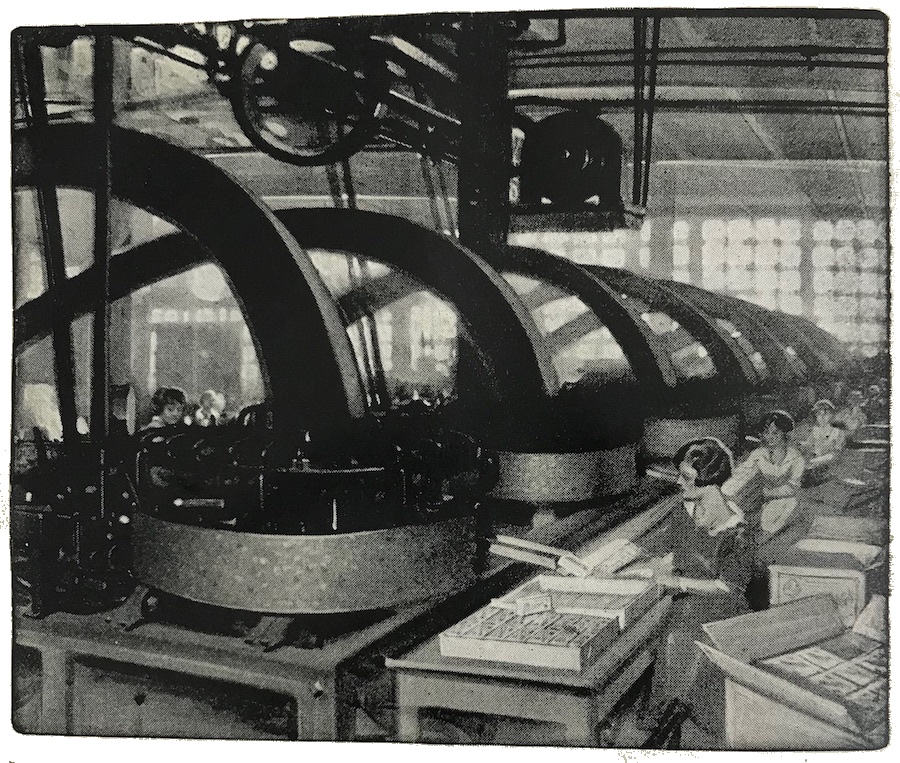 [Women working in the filling room of the Cracker Jack plant, c. 1920]
[Women working in the filling room of the Cracker Jack plant, c. 1920]
“Unpatriotic Motives”
Already established as a boss who didn’t particularly enjoy unexpected visitors to his office, Frederick Rueckheim—now at the ripe old age of 71—had grown even more curmudgeonly in his later years. Adding to this dynamic was the growing anti-German sentiment pervading the country during the Great War—a dynamic impacting thousands of German businessmen across the country. Some, however, were more adept at handling it than others.
On April 17, 1917—right in the middle of the war—a Chicago paper called The Day Book reported on a disturbing altercation at the Cracker Jack factory between Rueckheim and representatives from the Illinois Field Hospital corps.
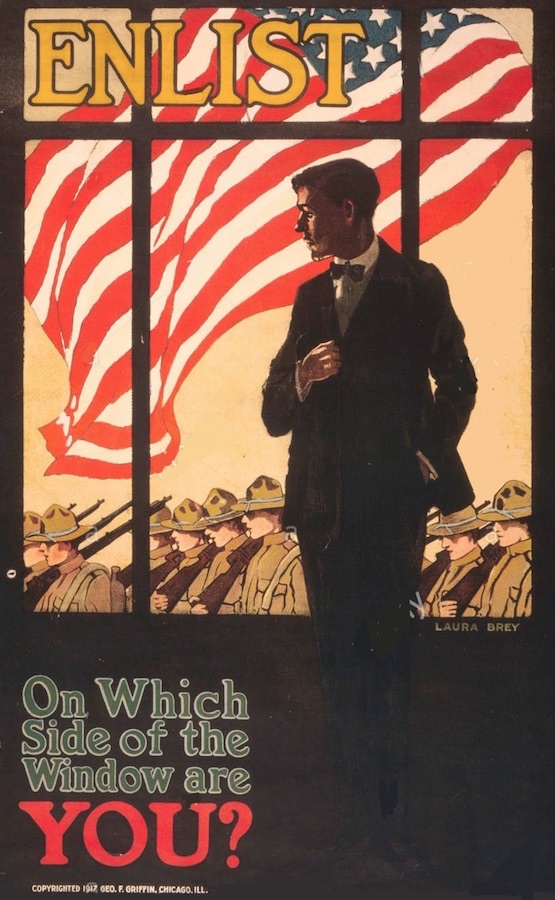 “Fred W. Rueckheim, ‘Cracker Jack’ manufacturer, is accused by 1st Ill. hospital corps sergeants of telling the officers they must keep out of his factory with recruiting and solicitation efforts.
“Fred W. Rueckheim, ‘Cracker Jack’ manufacturer, is accused by 1st Ill. hospital corps sergeants of telling the officers they must keep out of his factory with recruiting and solicitation efforts.
“A silver mounted picture of Gen. von Hindenberg [sic] stood on Rueckheim’s desk while he was bawling out the guardsmen as a ‘gang of beggars.’ That’s the allegation of the sergeants.
“Rueckheim denies unpatriotic motives, though he admits he simply must keep that picture of Von Hindenberg on his desk while he makes ‘Cracker-Jack’ for the American nation.”
That obviously wasn’t the most unbiased reporting in the world, but such were the times. Roughly a week later, Rueckheim—the former Prussian soldier—spoke to the press and defended himself more vigorously against charges of treasonous allegiances.
“These are indeed trying times for all of us,” he said, “but especially for those of us of German birth.” After explaining that he would happily welcome recruitment officers into the factory during appropriate business hours, and that the Von Hindenburg picture was merely part of a collection of pictures of all the major rulers of countries embroiled in the war (still weird), Rueckheim finally resorted to defending his honor as an American.
“I came to this city as a young man forty-eight years ago,” he said, “soon becoming a naturalized citizen of the United States, and never before has anyone questioned my loyalty or devotion to city, state, or country. Any call made upon me by my country in any capacity will be promptly answered.”
In those days before electronic or social media, the firestorm quickly chilled, but more tabloid embarrassment awaited.
Just two months later, in July of 1917, the classy reputation of the Rueckheim family was further rocked when news broke of a cartoonish brawl at the family estate at 4201 S. Vincennes Avenue. Frederick wasn’t involved, but his wife and two of his step children—Alta and Harry Roberts—were caught in the fray, along with family friend Robert Kimball. Their adversary, it seems, was the Rueckheims’ chauffeur, Fred Nelson, who’d opted to criticize Kimball for leaving the car’s lights running. Young Alta Roberts told Nelson he was out of line. Nelson quipped something back at her, and the rumble was on.
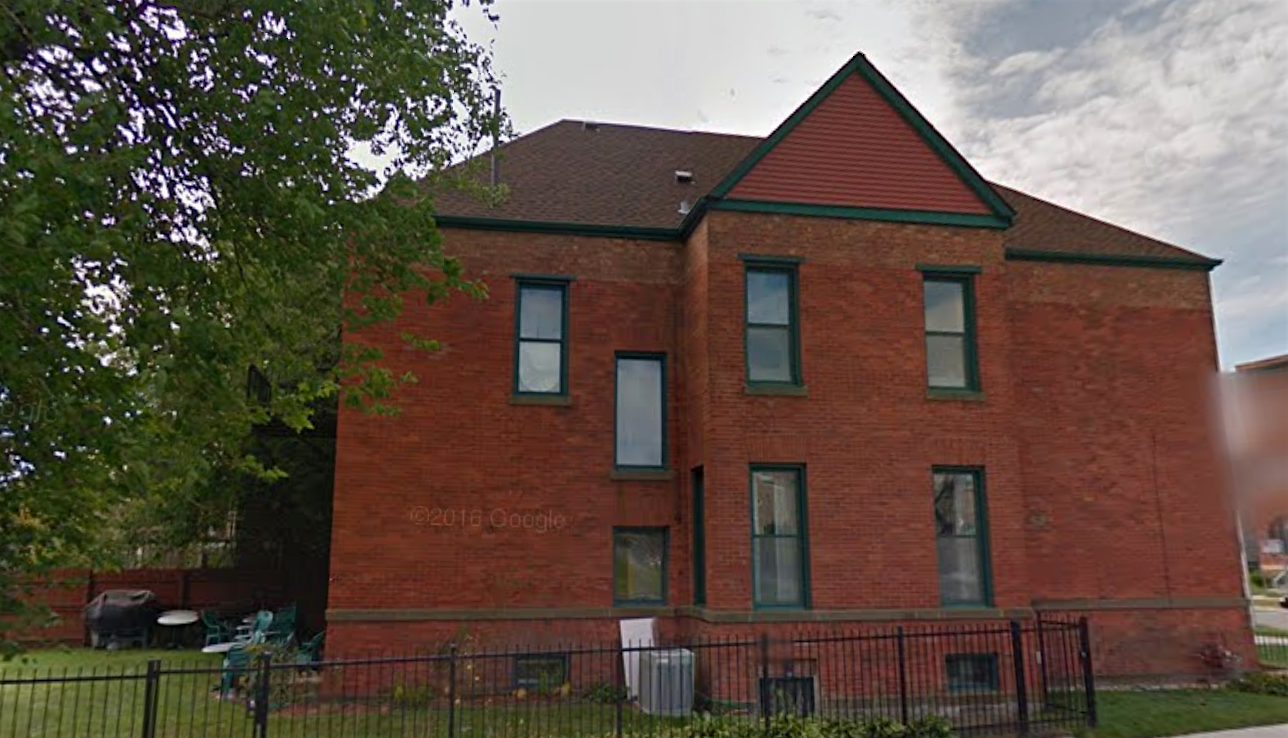 [Scene of the fracas: the former Rueckheim family home at 4201 S. Vincennes Ave. in Bronzeville]
[Scene of the fracas: the former Rueckheim family home at 4201 S. Vincennes Ave. in Bronzeville]
“Details of a free-for-all battle royal that would have crowded the most agile comedy from the movie screens were described yesterday before a jury in Judge Robinson’s municipal court,” the Tribune reported.
“. . . [Harry] Roberts tried to wallop the chauffeur and Kimball received one from Nelson. Miss Roberts, it is alleged, picked up a wrench and used it freely. After she lost it she scouted up an empty milk bottle. Finally Nelson was borne to the ground, and while lying there, according to testimony, Mrs. Rueckheim twisted his nose. . . . Mrs. Rueckheim and her daughter deny most of the assault charges, but Miss Roberts does admit the wrench part.”
There was no getting around it now. Frederick Rueckheim was in desperate need of a total public relations reset—for the good of his family, his company, and future generations. And so, over the next few years, he used his old salesman chops to redefine the Cracker Jack brand—not just as something upstanding and All-American in a baseball-friendly sense, but emblematic of childhood innocence itself; beyond reproach.
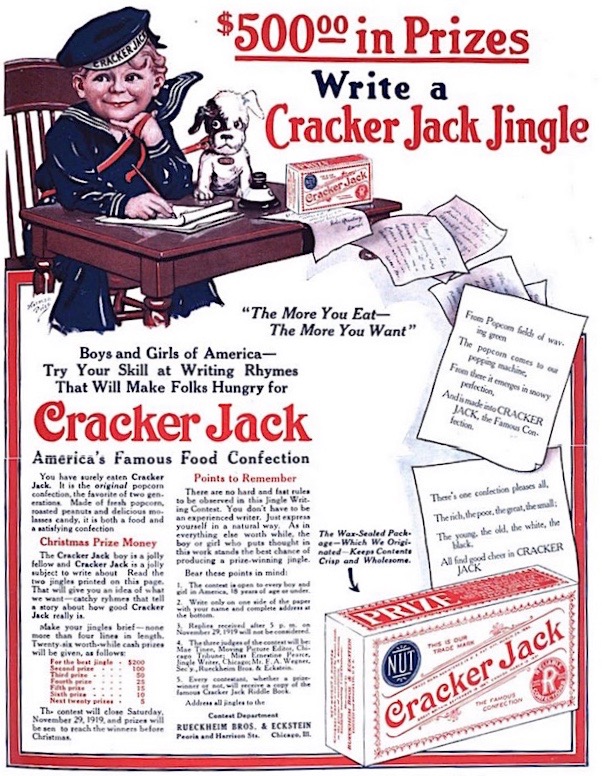
Sailor Jack Saves the Day
In 1918, the familiar, uber-patriotic Cracker Jack box debuted, featuring the new fictional faces of the company—a sailor boy named Jack and his spunky mutt Bingo.
“Cracker Jack has always been the particular favorite of young folks,” longtime company sales manager F. E. Ruhling wrote in a 1921 issue of Printer’s Ink, describing the strategy behind the now iconic design.
“It was certainly logical, therefore, that the trade character which we created should be a boy, jovial, happy, his arm full with three packages of his favorite confection. It is a trade character, designed to appeal to children, to work its way into their memory and make friends of them. And because every boy should have his dog for a pal, we gave the Cracker Jack boy his Bingo—a hybrid pup of questionable pedigree, but just the sort that every boy loves.”
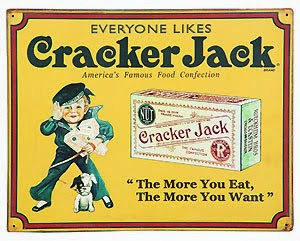 Ruhling made no mention of Jack being based on Frederick Rueckheim’s grandson—as became the legend—nor was Bingo based on H. G. Eckstein’s own dog (another highly unnecessary myth).
Ruhling made no mention of Jack being based on Frederick Rueckheim’s grandson—as became the legend—nor was Bingo based on H. G. Eckstein’s own dog (another highly unnecessary myth).
Again, it’s worth noting that this cuddly Cracker Jack imagery—which also included the company’s comparatively short-lived marshmallow mascot “Miss Angelus”—wasn’t exactly born from a simpler time. It was engineered to feel that way—a strategic campaign to hook customers, defeat the competition, and motivate merchants.
“It was simply an application of the lessons of the war to business,” Ruhling wrote. “The determination to keep up the morale of the fighting force. Morale is as important in business as in battle. When factory workers, salesmen, jobbers and dealers learn that the directing heads have uncompromising faith in the quality of the goods and the soundness of their policies, enthusiasm runs like an electric current through the whole organization.”
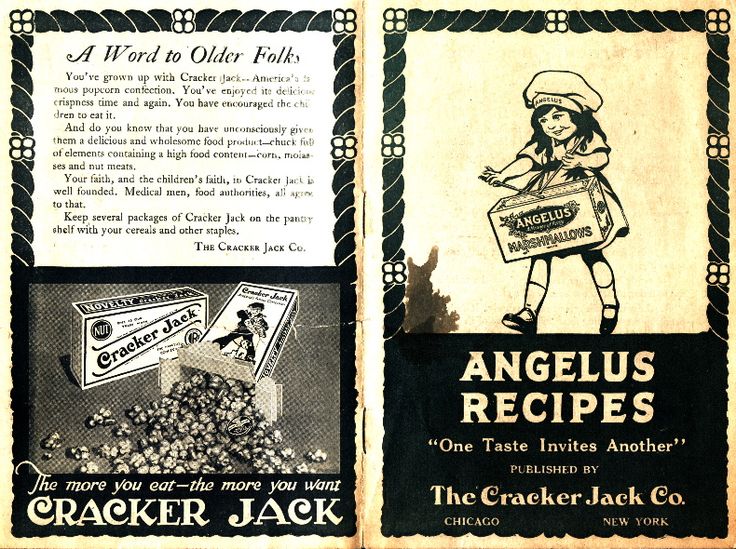 [While Sailor Jack has survived for 100 years, his friend “Miss Angelus,” on the right, couldn’t do the same with her marshmallows]
[While Sailor Jack has survived for 100 years, his friend “Miss Angelus,” on the right, couldn’t do the same with her marshmallows]
By 1922, on the 50th anniversary of the business, another major change was implemented. The company would reduce production of the lesser candies in its Reliable Confections line in order to focus on its flagship products. It would also shed the now off-putting German-ness of its name—Rueckheim Brothers was over, and the Cracker Jack Company was born. Even more significantly, the central day-to-day control of the business was finally handed off to the second generation, including Fred Rueckheim, Jr. and H. G. Eckstein, Jr.
“This younger generation has grown up in the organization,” the company announced, although Fred Jr. was hardly young at age 51. “They feel its traditions, its ideals, and its ambitions. They are conscious of the responsibility The Cracker Jack Co. owes to the public and to the industry. . . . The fine, sturdy character of the founders has so impressed itself on the institution that that character typifies the entire organization. You, and all of us, know that the business could not have lasted and prospered as it has if its foundation were not based on the rock of truth and fair dealing.”
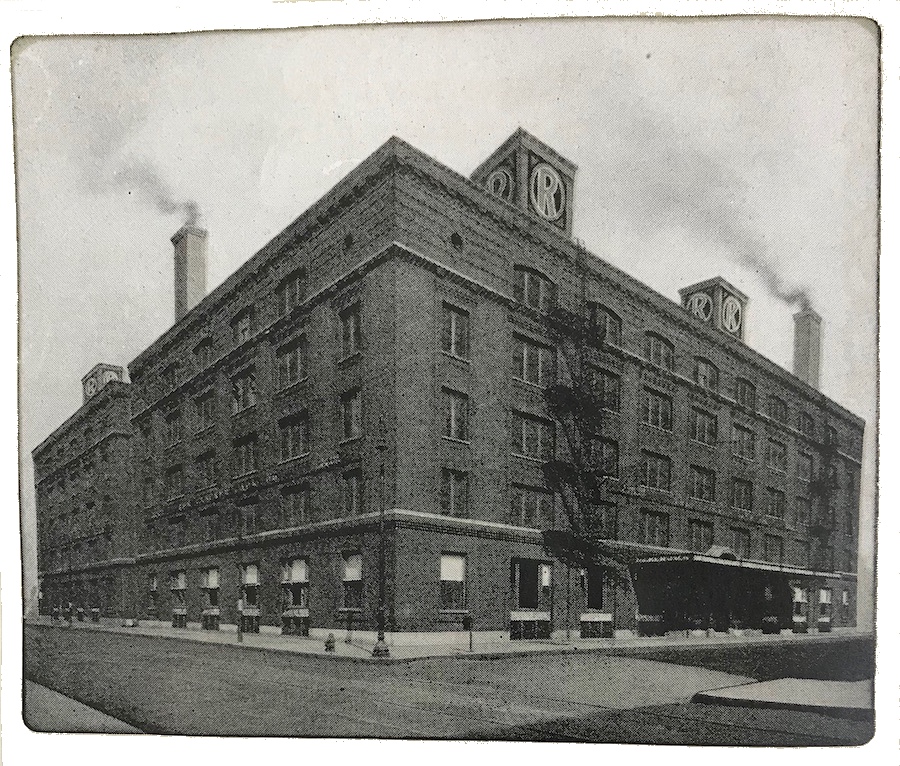 [Cracker Jack factory at Harrison and Peoria Street, 1920]
[Cracker Jack factory at Harrison and Peoria Street, 1920]
New Cracker Jack City
During this new wave of the 1920s, when the Cocoanut Corn Crisp in our collection was introduced, the company’s primary Chicago facility occupied a whole city block, located at the corner of Harrison Street and South Peoria. Here, they boasted about “methods of manufacture which deliver [the product] to the consumer untouched by human hands.”
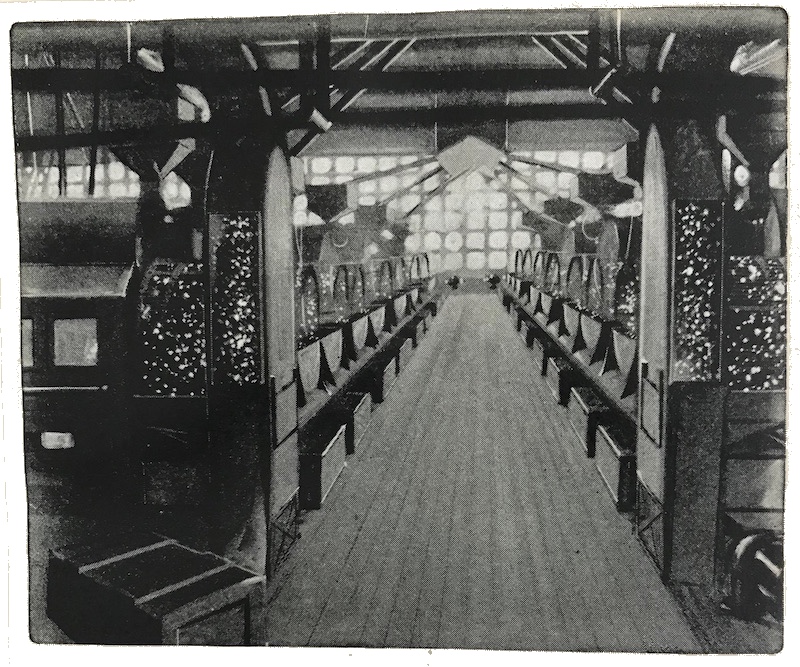 [A battery of automatic poppers at the Cracker Jack plant, 1920]
[A battery of automatic poppers at the Cracker Jack plant, 1920]
Child labor was mostly done away with, at last, if for no other reason than machines could now handle most of those tedious tasks. The modern Cracker Jack assembly line, such as it was, cleaned batches of peanuts on a conveyer belt, then cooked together with molasses in steam jacketed copper kettles. A timed release then dropped the peanuts and molasses into an awaiting kettle of popcorn—all sourced from Cracker Jack’s own private popcorn farm in Odebolt, Iowa (largest of its kind in the world). Automatic mixers evenly distributed the ingredients, and a filling machine directed each batch of Cracker Jack directly into its packaging in perfectly equal portions.
As state-of-the-art as this whole operation was, it still couldn’t keep up with a now international demand. Twenty-five percent of all the popcorn on the planet ended up in Cracker Jack’s kettles, and so, to keep pace, the new leadership convinced a now 84 year-old Fred Rueckheim Sr. to agree to the construction of a brand new $1.5 million complex in the Clearing Industrial District at 4800 W. 66th Street. It opened in 1931, brashly laughing in the face of the Great Depression.
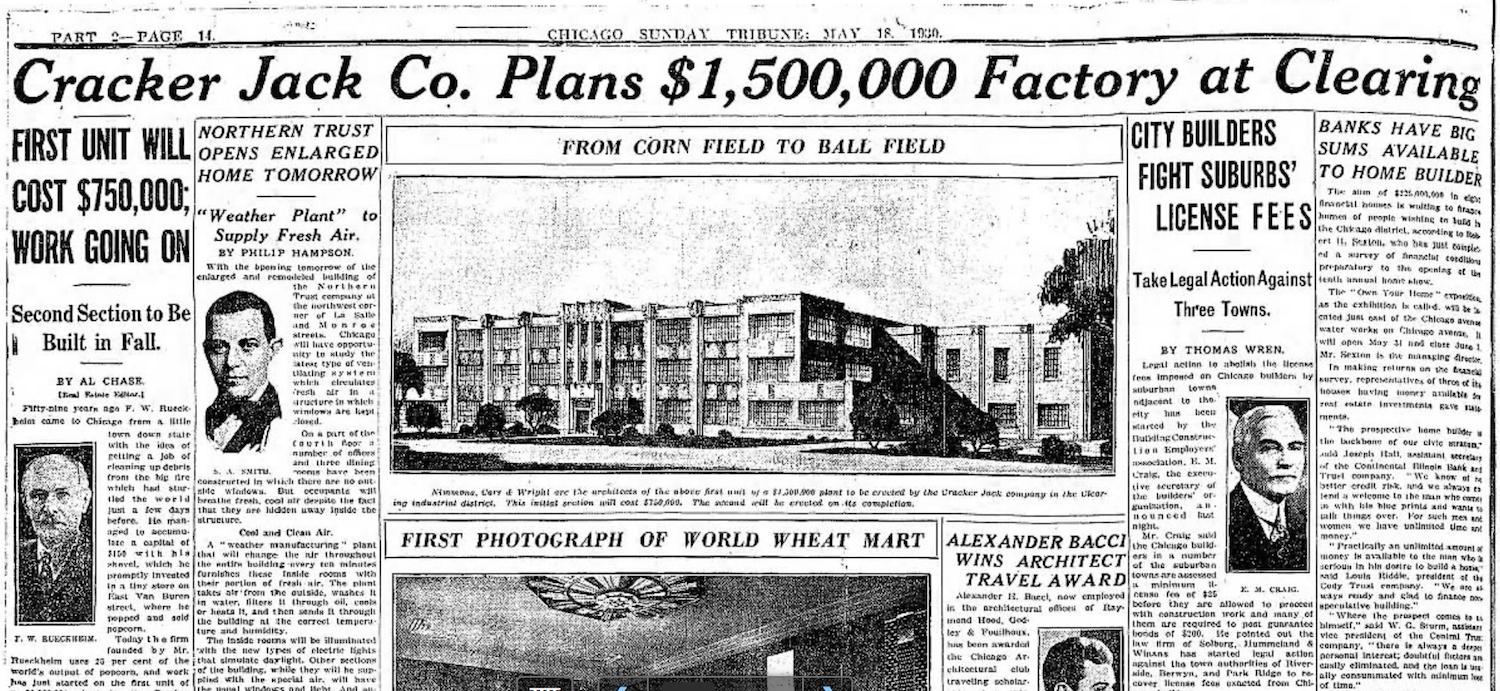 [The first year of the Depression didn’t stop Cracker Jack from announcing its investment in a massive new factory in 1930]
[The first year of the Depression didn’t stop Cracker Jack from announcing its investment in a massive new factory in 1930]
Louis Rueckheim, Cracker Jack’s inventor, never saw the new factory open. He died in 1927. Company founder Frederick Sr. followed him to the grave in 1934, passing the chairmanship on to his old friend Henry Eckstein Sr., who rudely died the following year. The reins were then passed to Frederick Rueckheim Jr., who “ran the business” passively for two years as a retiree in Arizona before his own death in 1937. H. G. Eckstein Jr. was up next in the president’s chair, probably a bit terrified at his own prospects of survival. But he managed to guide Cracker Jack through the rationing years of World War II, and eventually handed the presidency over to his VP Paul D. Allman in the early 1950s . . . without dying in the process.
The post-war years, before the company was sold to the Borden Company in 1963, were arguably the most successful era in Cracker Jack history. The factory on 66th Street, just a few blocks from Midway Airport, became a local landmark, with its giant, box-shaped Cracker Jack sign visible atop the massive structure. The surrounding grounds were landscaped with tulip gardens, and factory tours welcomed more than 10,000 children every year.
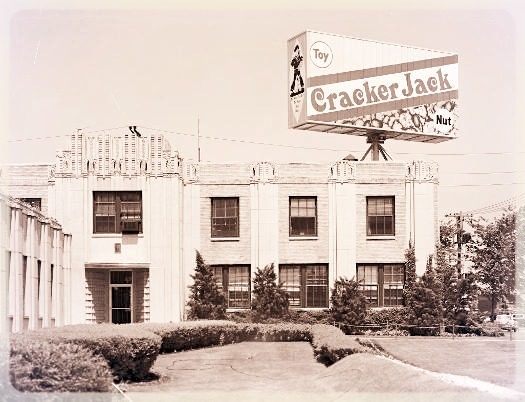 [The former Cracker Jack factory at 4800 W. 66th St. in Bedford Park, 1958]
[The former Cracker Jack factory at 4800 W. 66th St. in Bedford Park, 1958]
“The plant is as immaculate and orderly inside as outside,” the Tribune reported in 1955. “Eight hundred persons are employed in the production and packaging of Cracker Jack and marshmallows [by now, the Campfire brand was in circulation]. Company president Paul D. Allman said sales of Cracker Jack currently are twice as large as in the pre-war peak year of 1927.”
The plant at 66th and Cicero remained in operation for more than 50 years in total, finally shutting down in 1986. At the time, Borden (which had already moved the administration offices to Columbus, OH) shuffled many of the factory’s 400 workers into other facilities, including a company plant in suburban Northbrook. When Cracker Jack was sold to Frito-Lay in 1997, however, any lingering connections to Chicago were pretty well severed for good.
Postscript
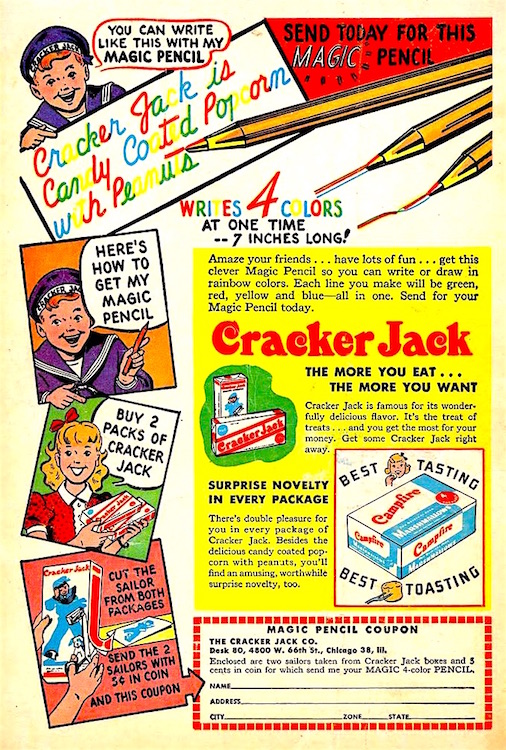 As mentioned, Frito-Lay took some flack for replacing in-the-box prizes with download codes in 2016, but the new approach is actually kind of a throwback to Cracker Jack’s old coupon promos of the past—for novelties like the “Magic Pencil” [see picture]. There’s more effort required, but maybe better returns.
As mentioned, Frito-Lay took some flack for replacing in-the-box prizes with download codes in 2016, but the new approach is actually kind of a throwback to Cracker Jack’s old coupon promos of the past—for novelties like the “Magic Pencil” [see picture]. There’s more effort required, but maybe better returns.
Frito has also pushed the envelope in recent years by introducing new, jazzed-up flavors of Cracker Jack, including “Buffalo Ranch” and “Spicy Pizzeria,” all in a semi-desperate effort to stir up sales.
The company’s VP of Marketing, Dave Skena, informed the Huffington Post in 2013 that the original Cracker Jack, as it stood for 100 years, simply wasn’t “relevant” to a young audience anymore. “Younger folks want more intense flavors and a wider variety of textures,” he said.
It’s a far from Cracker Jack’s Chicago heyday, when eager kids fished out an estimated 17 BILLION tiny prizes from the bottom of those boring cartons. Yes, most of those winnings wound up in dusty desk drawers and the spaces between seat cushions, but for a diehard community of modern-day collectors, they’re still a tangible gateway to a happy past. And they don’t care if they never get back.
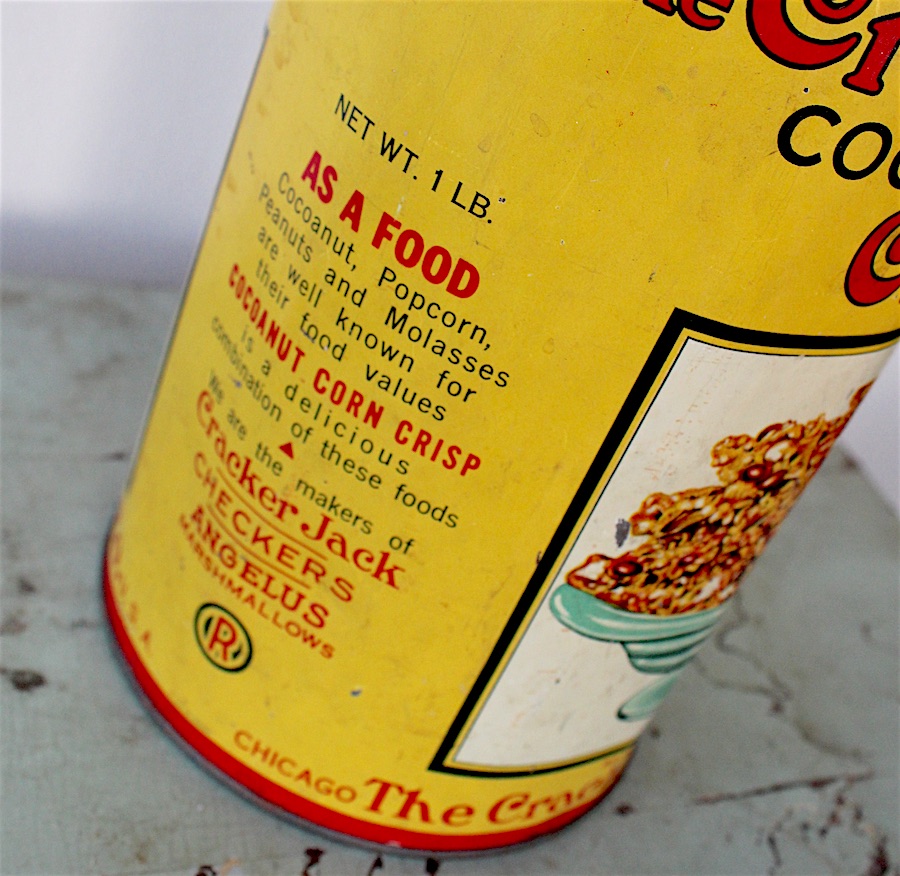
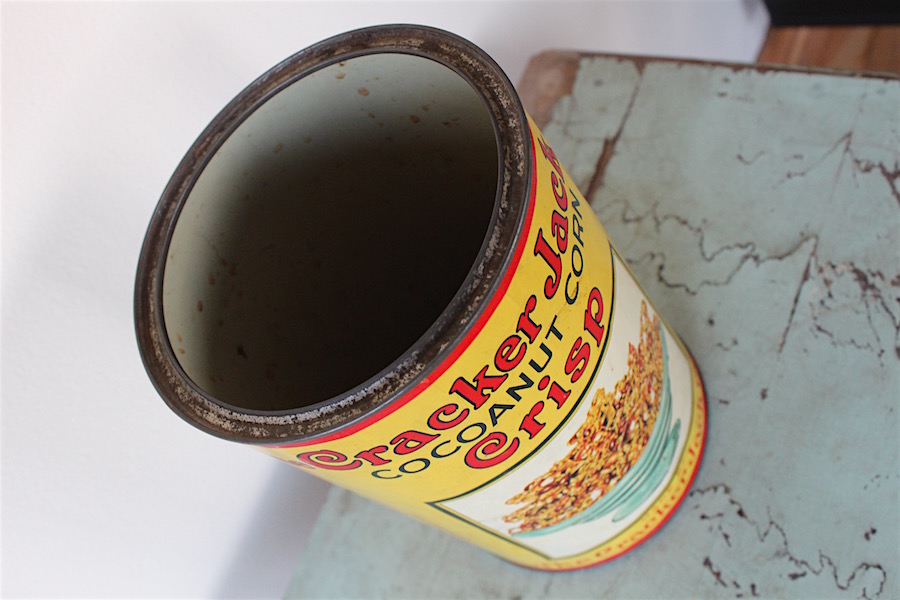
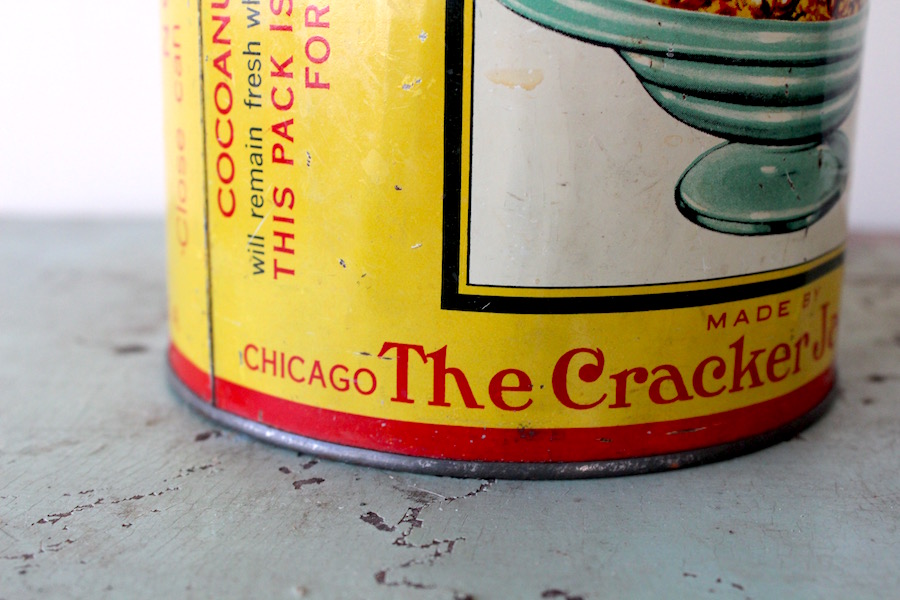
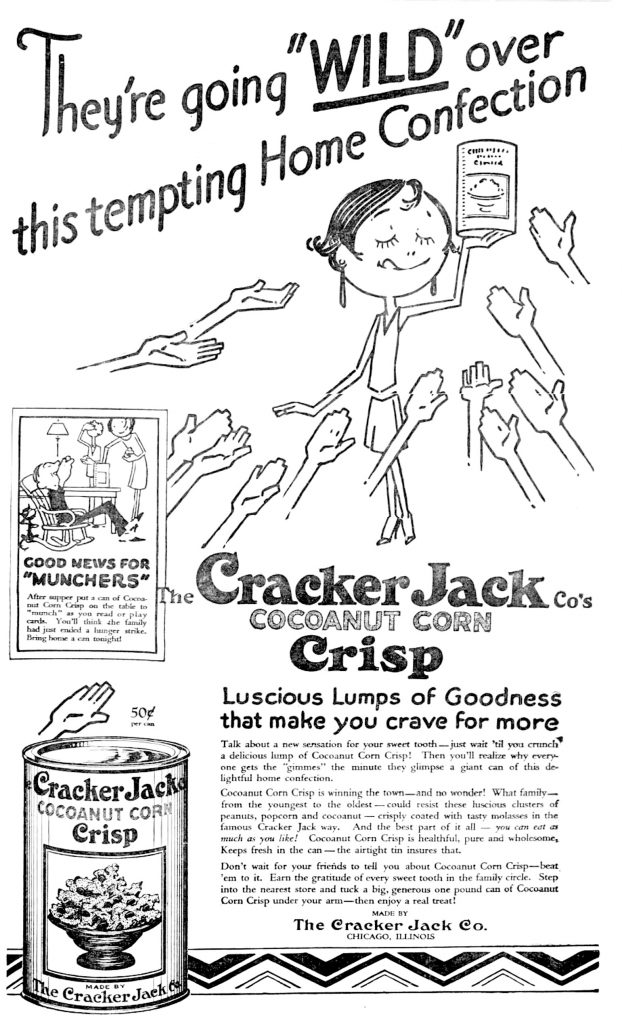
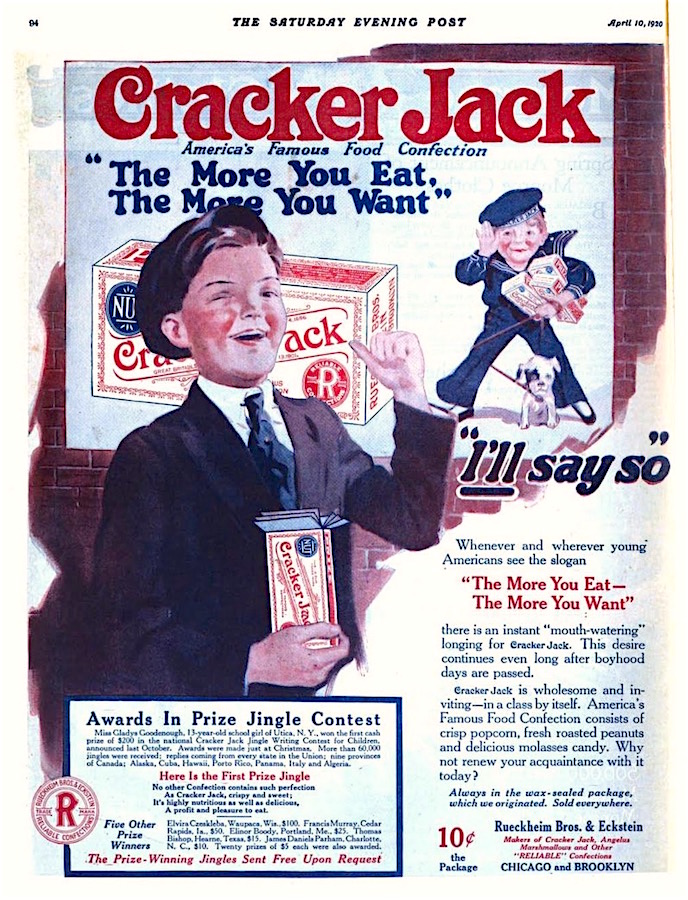
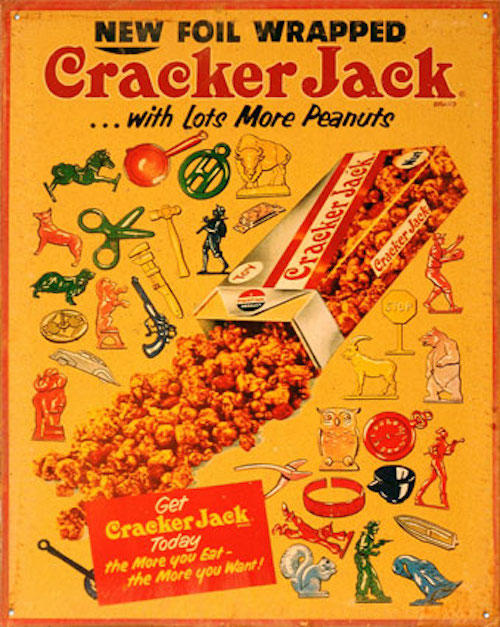
Sources
Fifty Years – The Cracker Jack Company, 1922
“Cracker Jack Plant Closes” – Chicago Tribune, April 15, 1986
“Cracker Jack Plants Draws Many Visitors” – Chicago Tribune, May 22, 1955
“How Cracker Jack Came to Follow the Circus Into Town,” by F. E. Ruhling, Printer’s Ink, Vol. 115, 1921
“Frederick Rueckheim” – by Samantha Chmelik, Immigrant Entrepeneurship.org
Popcorn Favorites, by John Podojil, 2013
Confectioners Journal, Vol. 45, 1919
“Do Not Taste It” – Chicago Tribune, March 8, 1896
“Factory Shut to Women” – Chicago Tribune, December 23, 1902
“F. W. Rueckheim Avows Devotion to U.S. Interests” – Chicago Tribune, May 8, 1917
“‘Who Hit Our Chauffeur?’ is Court Comedy” – Chicago Tribune, August 8, 1917
“Wedding In Chicago Ends Studio Romance” – The Inter Ocean, January 24, 1909
“Cracker Jack’D: Frito-Lay Gives Cracker Jack A Makeover With New Line” – Huffington Post, April 30, 2013
“Fred Rueckheim Denies Lack of Patriotism, But–” – The Day Book, April 28, 1917
Archived Reader Comments:
“My husband informs me..his family bought the grain bins from Cracker Jack, Odebolt Iowa. He hauled popcorn to Manson Iowa to Sheila B’s popcorn. Id like to know where was the popcorn farm. “Largest of its Kind” grown in Odebolt?” —Linda Bettin, 2020
“As a Northsider this is forever associated with Harry Caray’s 7th inning (7th Budweiser?) stretch, RIP Harry.” —Marc, 2019

All of the questions above and many, many more can be answered on the Cracker Jack Collectors Association website and by communicating with the members.
http://www.CrackerJackCollectors.com
I remember fondly our school visits to the factory. When we left, we were given boxes of crackerjack in a big bag, along with boxes of Campfire Girl marshmallows. What an amazing time. I’m not happy with the current crummy toys!😊
I have a 4″ x 5″ book titled “Animated Jungleland Book that was copyrighted in 1928. It obviously belonged to my mother who would have been 7 years old. Was wondering if you know anything about it including its worth. Any information you could send me would be greatly appreciated. On the back it says published by the Cracker Jack Co., Peoria, Harrison and Sangamon Streets, Chicago, USA Thank you for any help you could send me. Sandy Dumke
Rueckheim also made other candies and popcorn items that never made the market. I have found up to 4 items that were not sold. Very obscure names also.
Is there a library of archived Cracker Jacks prizes. If so, where is it located?
Thank you!
where can i get a list of movie stars and statesmen pinbacks from the 1930’s & 1940 baseball
pinbacks?